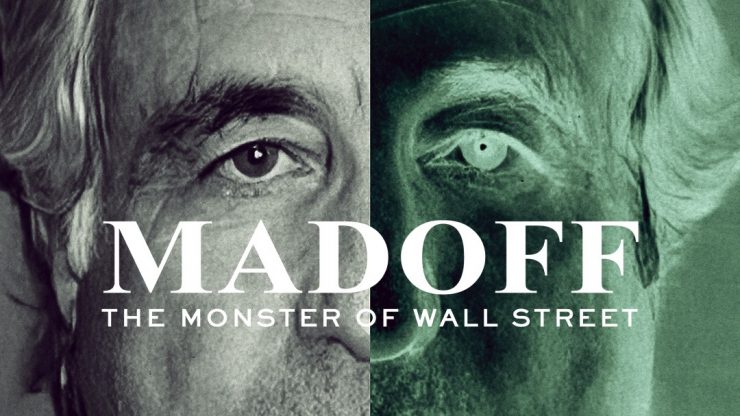
‘MADOFF: The Monster of Wall Street’ is a documentary series that details the Wall Street billionaire’s rise to power, fraudulent investing tactics, and eventual downfall. In the four-part deep dive by Academy Award nominee Joe Berlinger (Extremely Wicked, Shockingly Evil and Vile), journalists, victims, whistleblowers, investigators and Madoff’s former employees recount how the money-hungry investor pulled off the biggest Ponzi scheme in history.
The series examines Madoff’s infamous crimes and how countless systemic oversights led to a failure in preventing them. His victims and those who sought to bring them justice shed light on Madoff’s decades-long grift.
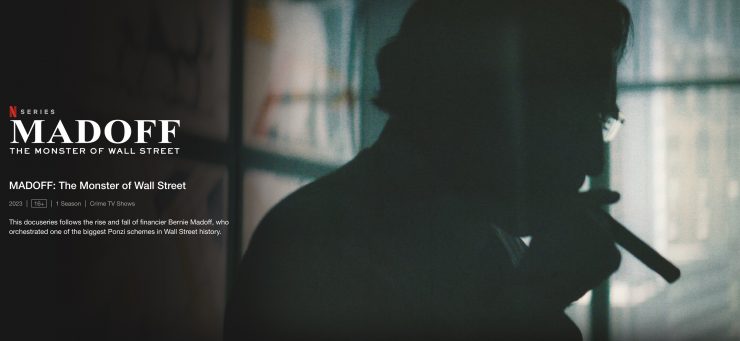
I caught up with DP Jeff Hutchens to talk to him about ‘MADOFF: The Monster of Wall Street’. I wanted to ask Jeff about his experiences shooting the show, because, in my opinion, this type of documentary is right up there at the pinnacle of factual shooting.
‘MADOFF: The Monster of Wall Street’ is not only beautifully shot, but it is also a gripping real-life story.
Please tell our readers a little bit about your background
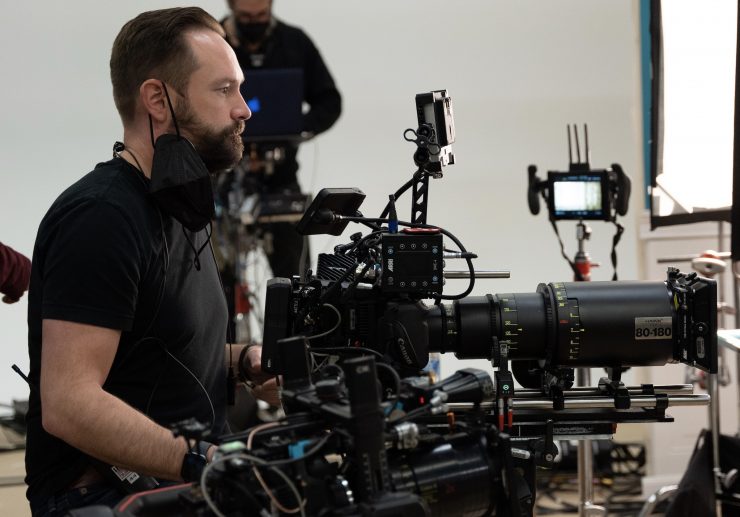
I was a magazine photojournalist for over ten years and shot mostly long-form, social-documentary projects across 70+ countries, before moving into cinematography in 2012. Since then, I’ve spent the last 11 years as the cinematographer on a variety of documentary series and theatrical feature documentaries for HBO, Showtime, National Geographic, and Netflix. Based out of New York City, I usually spend 7-8 months out of the year on the road for assignments and I recently co-directed and DP’d “Remember This”, a narrative feature film starring Academy Award Nominee David Strathairn, which will premiere theatrically in 2023.
What is “MADOFF: The Monster of Wall Street” about?
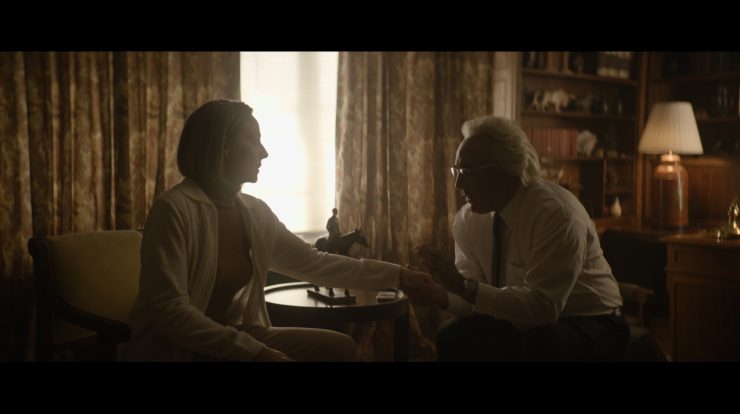
Our four-part Netflix series delves into the now infamous crimes of Bernie Madoff, a Wall Street titan whose fraudulent tactics cost investors billions of dollars before his eventual downfall and arrest amid the 2008 financial collapse. Through interviews with victims, whistleblowers, investigators, and Madoff’s former employees, the series examines his psychology and the innumerable systemic failures that created fertile ground for Madoff’s decades-long grift.
How did you become involved in this series?
I’ve DP’d a few Netflix series with our director (and Academy Award Nominee) Joe Berlinger. Our first collaboration came in 2019 on “Crime Scene: The Vanishing at the Cecil Hotel” which landed on top of Netflix’s Top Ten most watched list. I’d been recommended to Berlinger by our showrunner for that series (who I’d partnered with a couple years earlier on the CNN Original Series “Chasing Life with Sanjay Gupta”). Berlinger was also familiar with my work from the Showtime series “Murder in the Bayou”, a good example of my aesthetic – which I’d describe as a combination of naturalism and noir. He brought me onboard and we’ve developed a great and collaborative relationship ever since.
While shooting the second season of that Netflix anthology series (“Crime Scene: The Times Square Killer”) he mentioned his vision for the Madoff series with redefined recreation sequences blended with interviews, in a way that was organic to the themes of the story. I loved his pitch – Madoff’s infamous con is fascinating – and Berlinger wanted to approach this one on a different scale from other documentaries. I’m always up for a new creative challenge so I was immediately intrigued by the prospect of partnering up again.
The recreations are a little different from what you normally see. What was the thought philosophy behind this and was it challenging to come up with enough shots to use?
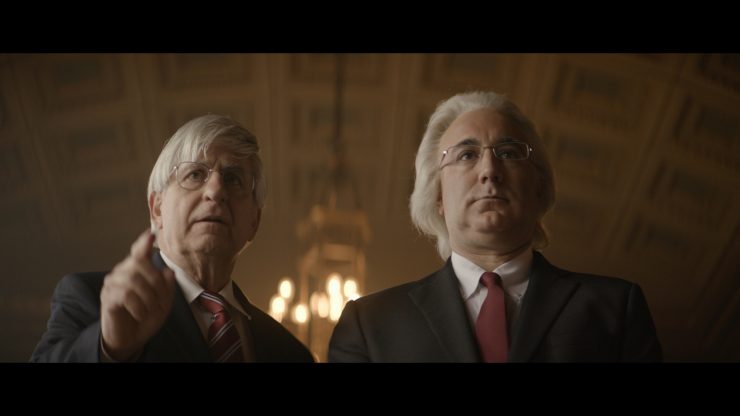
Madoff was a fraud. He created the trappings of a legitimate operation, but when investigators peeled back the curtain, it was all fake. We wanted to play with that concept in our series, so we created a staged replica of Madoff’s downtown Manhattan offices in the iconic Lipstick Building skyscraper. Like Madoff’s fake investment firm, this was the false staging we’d use to tell our story. We’d only reveal the artifice of our storytelling device at the end of episode three, when we walked our Madoff character off-stage, giving away the set build we used to tell his story and the crew that made it happen. This would be our editorial nod to the Potemkin village that was Madoff’s nefarious investment operation.
Using in-camera transitions, we wanted to seamlessly marry present-day interviews with recreated sequences, all filmed in exactly the same space with actors and interviewees sharing the same set. We wanted the series to fluidly flow back and forth between the two, all while taking place on our fabricated stage. These visual slights of hand would echo the way Madoff’s financial stage craft allowed his long con to flourish and deceive so many people.
The series has a very unique and stylized look. How was that decided upon and how much creative input did you have?
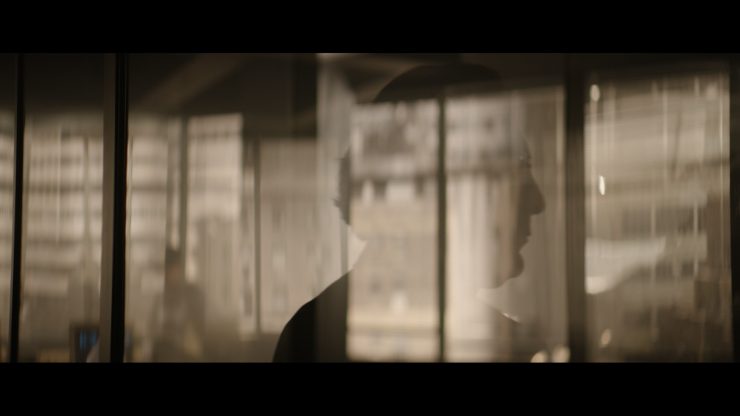
Berlinger had a very strong vision for pushing the envelope on how documentary recreations are used by creating this seamless blend, and one of the aspects of working with Berlinger that I appreciate most is the trust and freedom I have when it comes to creating our visual approach. We’re in constant dialogue as we translate the broad editorial ideas into actual footage and scenes. Every director I work with knows I’m fully engaged and ready to tackle whatever creative challenges come our way. Even more importantly, they know I’m invested in the details of the story and the editorial structure we’ll use to tell it – in addition to the technical and aesthetic considerations that fall on me as the cinematographer.
It looks like almost all of the recreations were done in the same building. Was that a real building and if so, what were the challenges of working in that environment?
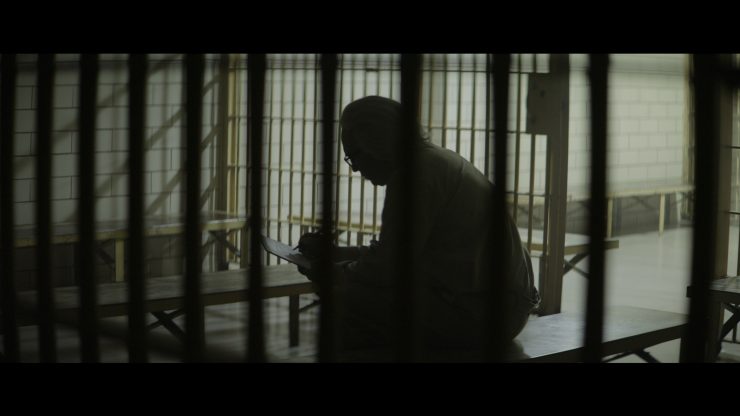
Early in the project’s development we scouted and considered shooting in actual office spaces, but as we fleshed out the ideas and the transitional conceits we wanted to use, it became readily apparent that we’d need to make a build of our own. We needed a completely controllable set to transition from interviews lit for daytime, to recreations lit for night, all in continuous shots.
Shooting on a stage gave us the advantage of control, but it also came with the challenge of creating enough different looks and styles in a finite space. Our stellar production designer Bryan Hodge and his team would change the set dressing for different eras of Madoff’s business as the technology and size evolved. On the camera side, we’d change lighting styles for every possible permutation of day and night, while compositionally slicing and dicing every square foot of the stage to give us as many different looks and editorial moods as possible.
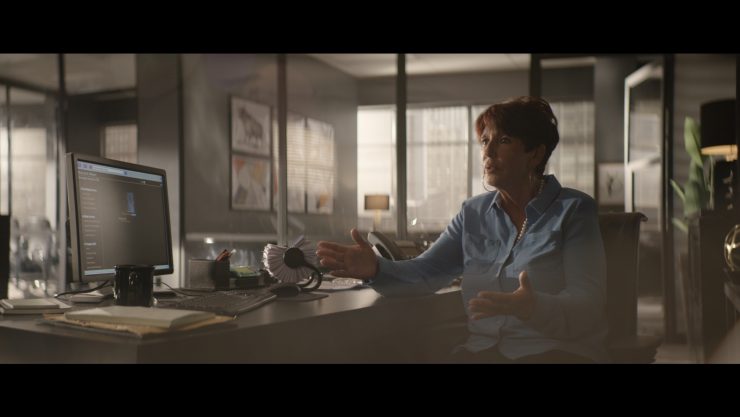
Only four or five interviews were done off-set in actual locations – those were mostly interviews with victims of Madoff’s fraud in Florida. On the recreation side, we created a few additional set builds in the studio space adjacent to the main stage where we filmed the early days of Madoff’s fraudulent business. The scenes in the Madoff family penthouse as well as the office of Thierry Magon de La Villehuchet were filmed in a residential neighborhood outside of NYC while Madoff in court and in prison was shot at an actual courthouse location. The dystopian b-roll from downtown Manhattan and Wall Street at night, which provided a visual bed to accompany Madoff’s tape-recorded depositions, was shot on a car-mounted Ronin 2 acting as a remote head in those actual parts of town.
What did you have to do to achieve the look of the series?
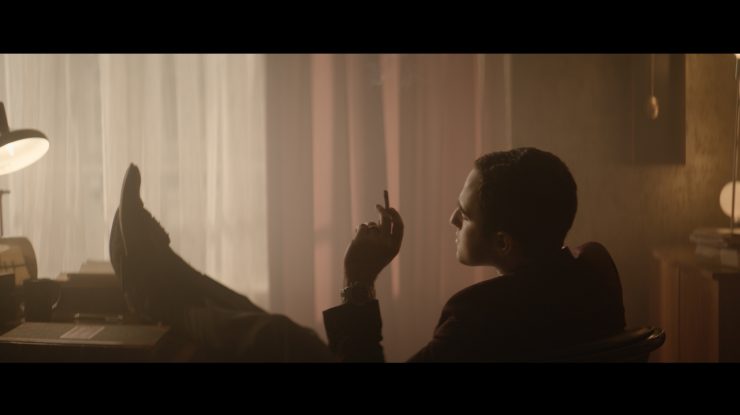
The series required an intense level of planning in pre-production to make our stage build work and sell the illusion. It also required a lot of creative problem-solving on our actual shoot days as well to map out those in-camera transitions as we went. Not only was every interview lit and composed to be a standalone interview, but every interview was also composed and lit to be the A side of an A to B shot which would transition into an entirely different time/place/scene/frame rate in recreation. Without giving away all our secrets as to how we created those transitions, I’ll just say we used a combination of reflections, variable frame rates, real-time lighting changes cued off a dimmer board, and camera movement.
VFX assisted us with some of the transitions that were impossible to achieve in-camera. But even with those I was hyper intentional to structure shot sequences so they always had clean ins and outs for easy stitching. That meant foreground wipes with extras, pans across office columns, pulling back from blown-out windows, etc. I’d start and finish all our recreation shots so they could be seamlessly blended in the edit. That kept our VFX additions to a minimum since many of those cuts worked as normal edits without additional assistance.
The lighting, especially the interviews, looks like it involves a lot of large sources to create bright, yet soft sources. What lights did you use and what were the challenges in keeping that lighting ‘look’ throughout the series?
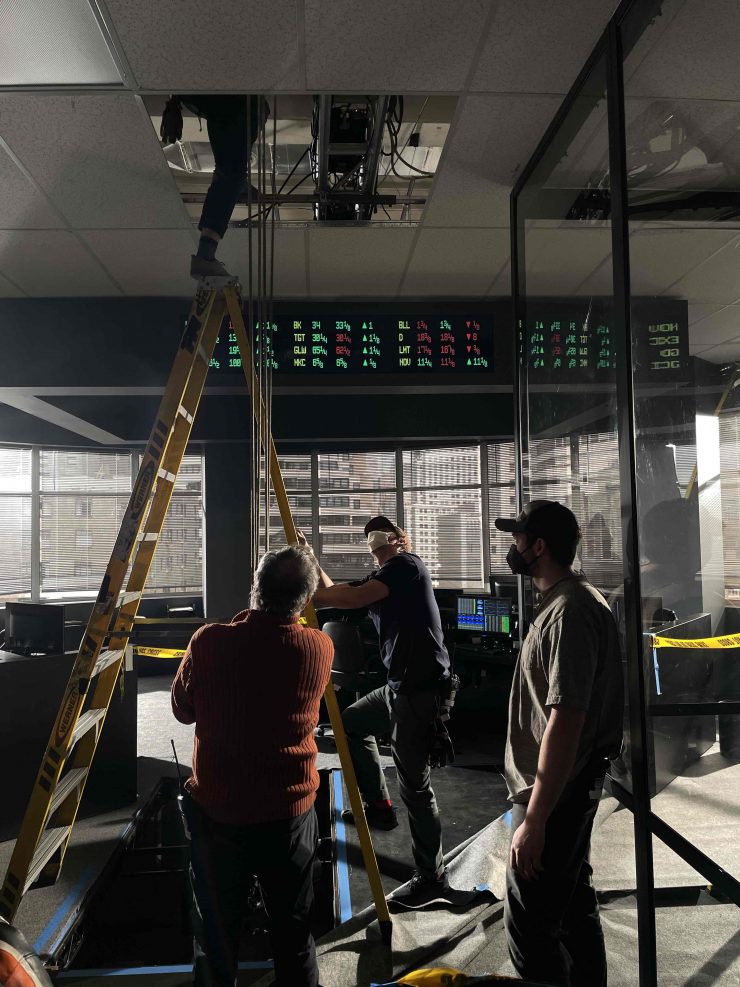
We ended up shooting with almost all tungsten fixtures and Kino fluorescents, which was the most cost-effective decision based on the size of our set. From the beginning, my goal was to mimic the movement of light in downtown Manhattan. I’ve always loved how light in a city comes from all directions — reflected, refracted, and skipped off the mirrored facades of neighboring glass skyscrapers. To achieve this naturalistic lighting for interviews and recreations, I’d ask our Gaffers T.J. Alston and Greg Addison alongside Key Grip John Shim and their teams to make mylar bounces to give us that specular lighting effect. We’d hit loosely wrapped pieces of mylar with Leko theatrical spots, or Dedolights to break up corners of interview and recreations frames with that sense of urban light.
For our “sun,” we had two 12K fresnels, a handful of 5ks, and a couple of 3ks. Those stayed on rollers to move as necessary depending on the shot angles. 95% of the recreations were long takes on a roving Ronin 2, so the camera often looked 360 degrees in unbroken sequences. Even though most of the fixtures were hidden behind structural columns, I’d still need to adjust the camera choreography on certain long takes to keep the shot clean.
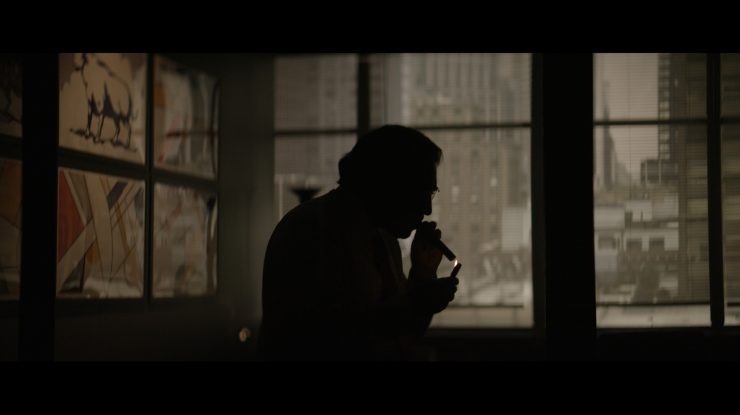
Mounted to our drop ceiling inside the set we had 3-4 fluorescent Kino tubes per overhead bank, but those saw relatively little action. They were all mapped to a dimmer board to selectively turn on or off when part of the frame needed an adjustment for mood.
We also had a couple of Litemat 4s, some Dedolights, and some Lekos that were mobile. We’d use those inside the set as needed. Astera NYX bulbs were plugged into our desk lamps. Occasionally we used them as the key light for nighttime scenes – but often they were dimmed down and used as points of interest to break up the background.
Madoff was a fixture on Wall Street and a key player in NYC’s financial industry. To sell the scale of Madoff’s whole enterprise we needed to see Manhattan outside the windows of his office (our stage) – we couldn’t just cover the set windows with diffusion and blow them out. Surrounding our entire set was a 25ft. tall by 156ft. wide Rosco SoftDrop backdrop. The beauty of these cotton (not vinyl) backdrops is that you can light them from below and behind for a nighttime look with illuminated windows and a darker sky, or you can light them from above and in front for a daytime look with a brighter sky. During nighttime sequences, we’d add floor-level Arri Skypanels on the front side of the backdrop, colored as sodium vapor to give the impression of streetlights. We’d also use Christmas light strands selectively placed and screwed/unscrewed for twinkling city lights in the distance.
Early on in prep, I asked our production designer for miniblinds on all our outward-facing set windows. I wanted the blinds to help break up our background and hide any imperfections we might otherwise see. We were exceptionally tight on space to fit both our stage build and the backdrop into our studio, so the backdrop was a few feet closer than ideal for selling the perspective and illusion – the miniblinds were crucial for breaking up the backdrop’s shape.
There were clues sprinkled throughout Madoff’s life and business that not everything was as it seemed – so in that same way we were okay with the occasional uncanny element showing up as a subtle reminder of Madoff’s deception in our visuals as well – we had the editorial latitude to see cracks in our filmmaking illusions.
What camera & lens combination did you use?
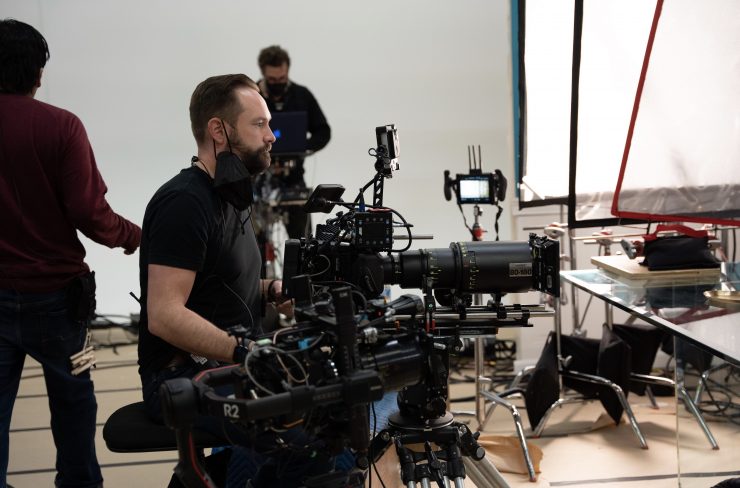
We used two Canon C500 Mark II cameras. The A-camera lived on a Ronin 2 (which we’d tripod mount for interviews to save time changing over the build for recreations) with Cooke 2x Anamorphic prime lenses, most often a 50mm or 75mm, sometimes a 100mm. The B-camera I’d use for graphic plates and lock-offs, as well as the tighter second angle for interviews. We started that camera on a Cooke 30-140mm Anamorphic zoom originally, which was f/3.5. A few days into the shoot though we switched that out for a Hawk 2x Anamorphic 80-180mm zoom (f/2.8) for more flexibility with light levels.
The third style of lensing we’d use was a Kowa 75mm 2x Anamorphic prime. I’d stack that with between +1 to +4 diopters (affectionately called the “Big Mac” when we’d stack all three +1/+2+4) for detail shots and atmospheric plates for graphics. We knew the series would need a decent number of financial and technical explainers, but we didn’t want to pull the viewer out of Madoff’s space. I would shoot a blank piece of paper coming out of a copier, or a lock-off of a conference room whiteboard, or an empty notepad on a desk – mundane office details that we could use as templates for definitions and graphics, but templates that would keep us firmly in Madoff’s world.
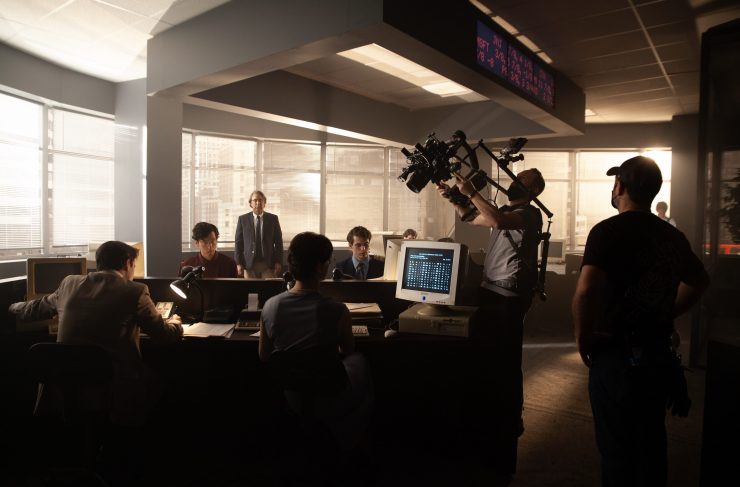
I shot almost all the recreation work handheld on a Ronin 2 with a Ready Rig for support. Our 1st AC on the series – Filipp Penson – is a focus-pulling machine. Despite fluid blocking, and no focus marks, while shooting wide-open on funky anamorphic lenses with a full-frame sensor, he would nail take after take. Knowing that we could count on him to land every shot freed us up to shoot efficiently and follow our instincts with blocking adjustments on the fly.
Did you have to test out a lot of camera and lens combinations to find the one that ultimately would provide you with the ‘look you were after’
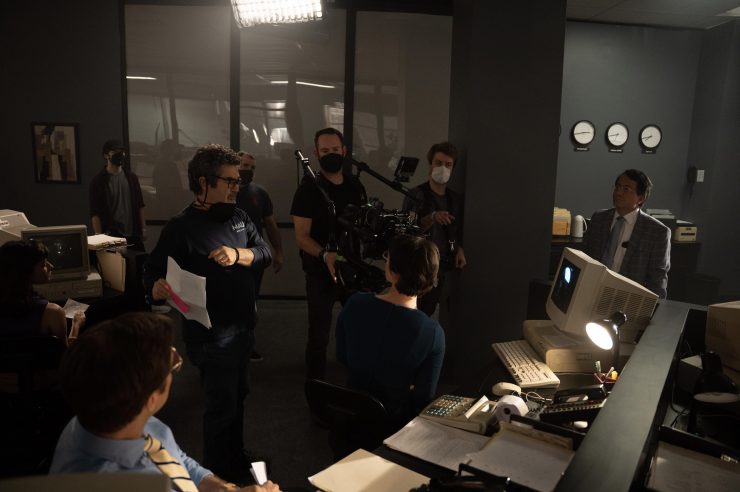
We knew we wanted to shoot anamorphic – it was just a matter of testing lenses and checking camera specs to meet Netflix’s technical requirements for a 2x anamorphic, 2.39:1 aspect ratio, delivery. We needed frame rates as fast as 60fps, so that took the Alexa MiniLF out of contention (it will only shoot up to 40fps while meeting Netflix’s technical requirements for 2x anamorphic, 2.39:1 delivery, and the Alexa 35 was not available yet). The Sony Venice was another option, but its size and weight were heavier than I preferred, knowing that I would be shooting almost all the recreations on a Ronin 2 for hours on end.
One surprising trait of the C500 Mark II is you can still shoot a lot of Super35 anamorphic lenses with the camera, even though it’s a full-frame sensor. If we stayed tighter than 40mm we could shoot S35 lenses without vignetting, and with that full-frame sensor, also pull in a little extra anamorphic texture on the edges of the frame. We shot 6:5 full-frame Cinema Raw Light.
How big was the crew?
Our crew size fluctuated depending on the scenes, the set builds, and the different phases of production. Our largest day must have been over 100 of people on set including extras, while our smallest day was a B-roll day with just four of us.
How long did the series take to shoot?
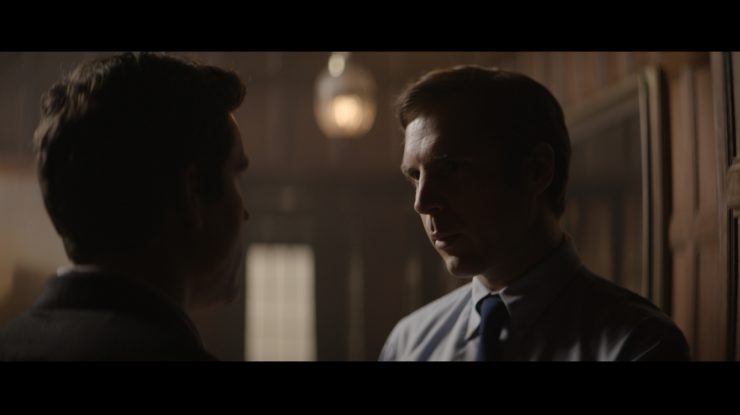
We shot about 30-40 shoot days altogether, spaced out over a few months.
What were the challenges or obstacles you had to overcome?
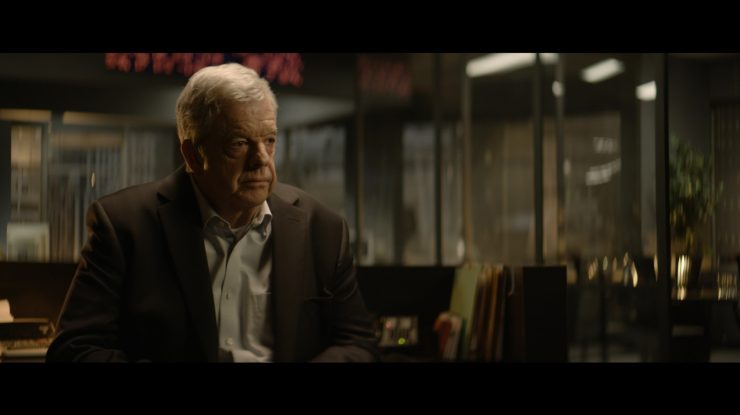
Keeping the series visually fresh while shooting it all in that relatively confined space was our biggest challenge. Even though it was a sizable build with tremendous attention to detail, we had to max out every square inch of the set shooting so many recreation scenes with so many interviews. But that was also what made this series such an engaging creative challenge! One of the best parts of production is working within a defined set of limitations – within reason of course – then it’s reliant on your creativity as well as every other department’s creativity to bring ideas that will elevate the work beyond those limitations.
What was the most difficult shot or scene you had to do? Walk us through how you approached capturing that
Madoff’s legitimate business was on the 19th floor of the Lipstick building, while his Ponzi scheme simultaneously operated two floors below on the 17th floor. From the beginning of production, we knew we wanted to do a shot connecting his two worlds, a descent from the reputable to the fraudulent.
We rigged the camera with the Ronin 2 to a pulley system attached to the studio grid. For a clean in-camera start and finish to the shot we pulled out a couple of pieces of drop ceiling from the roof of our stage and a piece of decking from our stage floor, to allow the camera to pass through both planes as natural cut points.
To keep the shot interesting, we wanted to continuously pan the camera as it was lowered. The only problem was the Ronin 2 could only BARELY squeak through the stage decking when static, and when panning we could only fit through the cutout if we landed the shot in exactly the right orientation and angle. Even then we still had one of our grips underneath the stage to help guide the camera down. We did quite a few takes before successfully threading the needle and landing the right choreography all in one shot.
Our 19th-floor set build and our 17th-floor set build were the same spaces, redressed just a few weeks apart. After we turned the set dressing over from the 19th to the 17th, we repeated the shot and merged the two pieces together in the edit.
What did you learn from shooting this series?
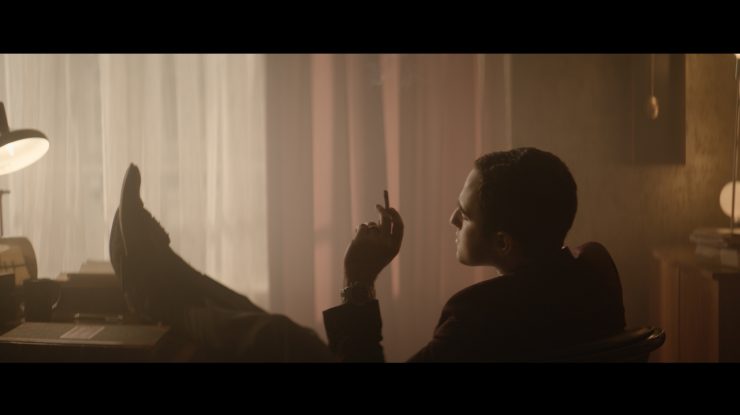
How to successfully pull off those in-camera transitions – the technical and creative equation we needed to make those work in a documentary, where not all variables are controllable. This was also the first time I’d worked with a Rosco SoftDrop, and the paradoxical amount of illumination it needed to create a believable night look was a surprise to us.
Is there anything you would have done differently?
If we’d had the resources, I would have loved to use SkyPanels rather than tungsten fixtures for our backdrop lighting, and Astera tubes instead of Kinos in our ceiling. It may have opened up a few more looks for us (maybe we could even have pulled off a thunderstorm!).
Were you happy with the end result?
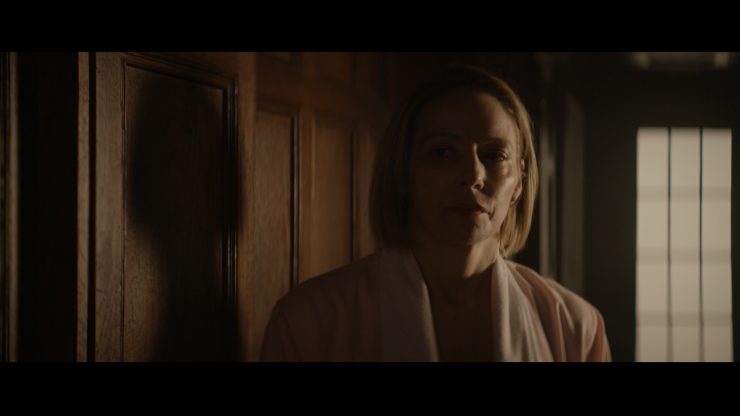
Yeah, definitely – the series debuted at #2 on the Netflix Top Ten most viewed list – and there’s been an amazing response from folks in our field to both the series as a whole and the blend of visuals that we created. And for me personally, it was a great chance to hone skills that will be useful going forward as I look to shoot more scripted projects.
Where can people watch “MADOFF: The Monster of Wall Street”?
You can watch the series on Netflix.
If you want to find out more about Jeff Hutchens:
www.jeffhutchens.com
IG: jhutchphotofilm





